Menu
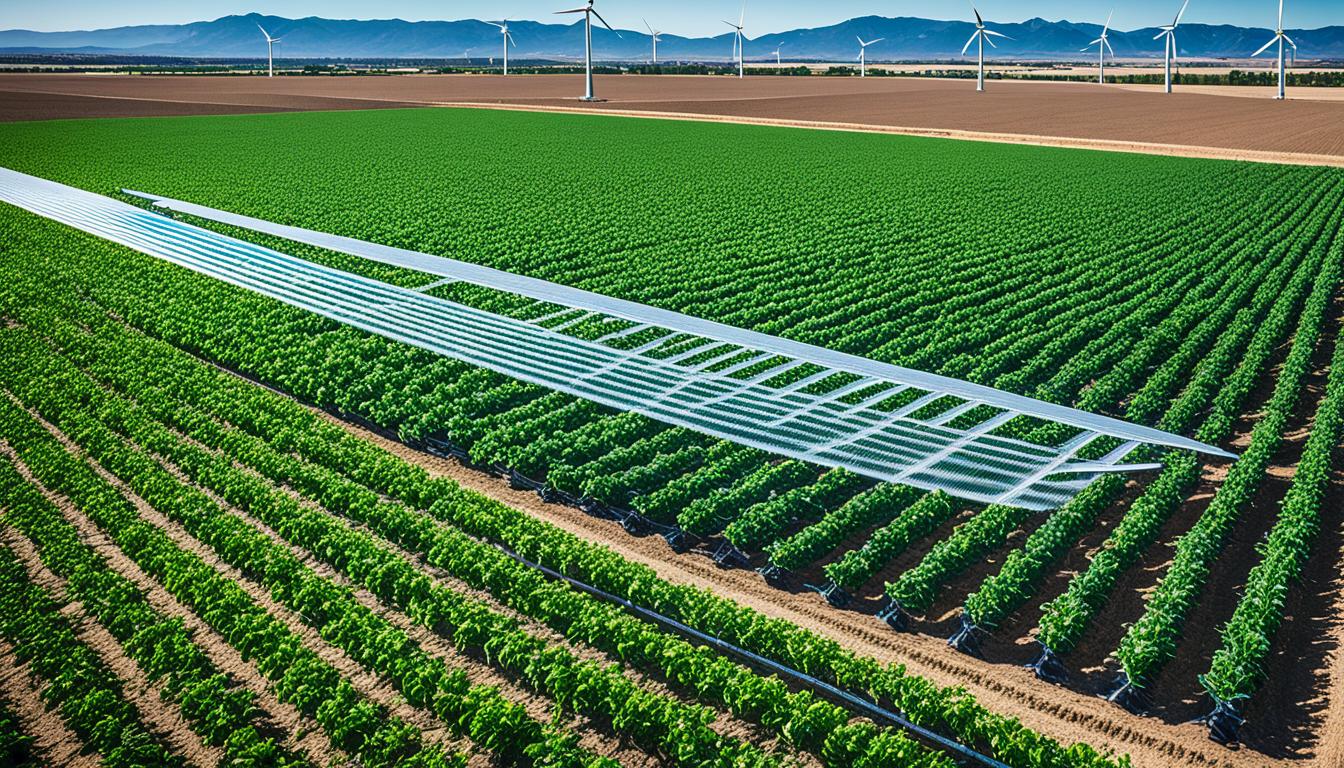
Did you know the need for food will jump by 70% by 2050? This figure is huge, especially when almost 10% of people are hungry. Quick population growth and climate changes make this even more urgent. Organic farming tech offers hope for the future of farming and life on Earth.
Visimex Corporation has been a leader for over 20 years in exporting Vietnamese agri-products. Their role in the organic farming world shows how modern tech and old practices can work together. For instance, drones with cameras are helping farmers know more about their crops. This shows how high-tech tools are key in organic farming.
Blockchains are changing the game too, by making organic food supply chains very clear. This tech is key for keeping foods, real identities, and stories connected. It boosts trust in what we eat. Visimex is getting ready to shine at Biofach 2024, showing their big push in green farming.
Eco-friendly farming has changed how we see farming today. It uses organic practices and green technology. This makes farms work better while looking after the planet.
Today, farms use moisture sensors, aerial imaging, and GPS for farming. These help farmers use water and fertilisers better. This improves crop growth and caring for the environment too.
Organic farming is getting bigger. In Germany, farms have reduced but got larger. This shows a move to more efficient and tech-savvy farming.
More farms are choosing to go organic. Over 20 years, the number has grown a lot. This shows that these methods are working well for the planet and the farmers.
“The Huabahof farm in Upper Bavaria exemplifies the successful integration of energy-efficient practices in organic farming, as it produces two-thirds more energy than it consumes, contributing to a more sustainable agricultural model.”
The Huabahof farm in Upper Bavaria is a great example. It’s an “Energy Plus Farm” that produces more energy than it uses. WESTHOF BIO in Schleswig-Holstein also shows how big organic farming can be with its greenhouses.
Organic farming is about more than just growing crops. It also means looking after animals and the environment. Farms like Huabahof and WESTHOF BIO are leading the way with eco-friendly practices.
Robots and AI are also changing organic farming. WESTHOF BIO’s weeder robot is very accurate. It shows how technology fits well with organic farming.
| Metric | Conventional Farming | Organic Farming |
|---|---|---|
| Farms in Germany (2022) | 258,700 | ~80,000 |
| Average Farm Size | 62 hectares | 50 hectares |
| Energy Consumption | Standard | 28%-32% less |
| GHG Emissions | Higher | ~20% less |
Green farming technology, from sensors to robots, is the future. It means farming can meet our food needs sustainably. This helps keep the planet healthy for the long run.
Bee Vectoring Technologies (BVT) is changing the game in organic farming. It uses bees to protect crops in a friendly, sustainable way. Bees carry good bacteria or fungi on their legs and spread it as they move from flower to flower. This helps plants fight off pests and diseases without harmful chemicals. BVT boosts farm sustainability, improves crop output and soil health, and is suitable for various crops and farms.
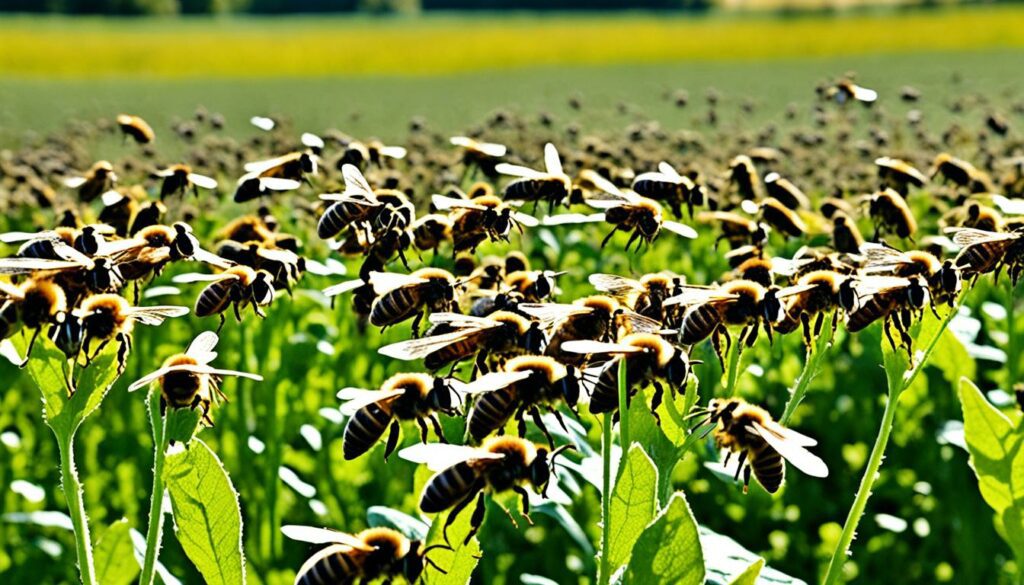
Bee vectoring technology is all about using bees to make crops healthier. Bees are given a tiny bit of a safe substance when they leave their hives. They then pass this substance on to plants they visit, stopping pests and diseases. It’s a very targeted method, avoiding the need for lots of spray all over the farm.
Using bee vectoring can massively increase how much and how good crops are. For example, Major League Blueberries (MLB) made 22 times more money by fighting off fungus and stopping fruit from falling early. In Georgia, using BVT helped blueberry farms make 28% more fruit, with less disease. This means farmers can grow healthier crops thanks to better pollination.
BVT’s big plus is how it’s good for the planet. While regular spraying harms nature with its chemicals, BVT is only where it needs to be. It also doesn’t waste water like spraying does, saving huge amounts. This method is kinder to nature, as it cuts down on chemicals, machines, and water.
| Parameter | Traditional Methods | Bee Vectoring Technologies |
|---|---|---|
| Chemical Usage | High, with 95% spillover | Minimal and targeted |
| Water Consumption | Hundreds to thousands of gallons | None |
| Environmental Impact | Significant biodiversity disruption | No spillover, eco-friendly |
| Yield Increase | Varies, potential chemical residues | Up to 28% (as proven in trials) |
| Return on Investment | Varies, less efficient | Up to 22x (reported by MLB) |
Precision agriculture is changing how we farm by using resources better and promoting green crop care. With smart tech in farming, we can make choices based on data. This boosts how much food we grow.
Essential parts of precision farming are about collecting, processing, and looking at data. GPS, drones, and space photos help us know what our crops need and what the land is like. These tools create detailed plans for farming based on soil and what plants need.
Precision farming uses tech on the ground, in the air, and from space for checking and analysing things as they happen. Ground tools like GPS track where water goes, helping find problems.
Drones watch over crops and check details, making farms work better. With satellite tech, farmers can see how their crops are doing and decide what they need. VRT means only using things like water and food where they are needed the most on a farm.
The future of precision farming looks bright. It could be worth $16.35 billion in 2028. Adding AI and learning machines will give us even smarter advice for farming. By using these high-tech ways, farmers can grow more food and spend less, keeping the planet healthier.
Indoor vertical farming is a big step forward in farming. It makes the most of small spaces. This method uses hydroponics and aeroponics. It lets us grow plants in controlled spaces. This increases how much we produce and helps the environment.
Hydroponics grows plants in water, not soil. It feeds them directly with the vitamins they need. Aeroponics sprays plant roots with these nutrients. This helps plants to grow well using less water. Both ways help us use resources better and cut waste.
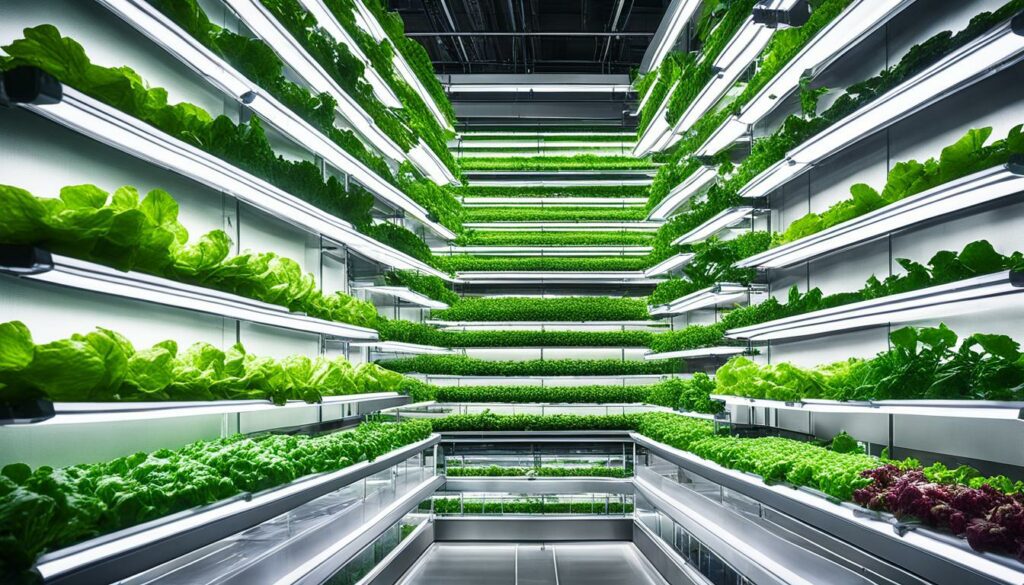
Vertical farms save a lot of water, up to 70%. This is very important in areas with little water. These farms can grow crops all year. They are not worried about changing seasons. They also need fewer pesticides. So, the food they make is safer to eat.
Aerofarms in New Jersey uses very little water and land. It’s much more efficient than regular farms. Iron Ox grows a lot of crops in a small space. It uses much less water. Babylon Micro-farms grows food quickly. It uses less water and no pesticides.
These farms show how indoor farming can change agriculture. They are getting a lot of support from investors. For example, Softbank gave $200 million to Plenty. This shows many people believe in the future of indoor farming. As the world gets more crowded, we need smart ways to grow food.
| Company | Water Reduction | Yield Increase | Special Features |
|---|---|---|---|
| Aerofarms | 95% less water | 390x land efficiency | High land efficiency |
| Iron Ox | 90% less water | 30x yield per acre | Robotic systems |
| Babylon Micro-farms | 90% less water | 2x faster growth | On-demand service, pesticide-free |
Indoor vertical farming is quickly growing. It’s a key method for better farming. Future research will make it even more sustainable. This will lower costs and assure there’s enough food for everyone.
Advanced livestock technology is changing how we farm, making it better for animals and boosting what we produce. Things like automated dairy set-ups and cleaning gear cut down on work and make things cleaner for the animals. This leads to more stuff being made on the farm.
One standout is using sound waves, acoustic pulse technology, against bovine mastitis. It’s a big deal because it tackles a major health problem without using antibiotics. This makes the animals healthier and helps the environment by supporting sustainable farming.
Then there are the automated feeding systems that meet every animal’s dietary needs. They make sure each animal gets the right food. This boosts farm productivity and keeps the animals healthy.
Now, let’s compare the effects of these innovations:
| Technology | Benefits |
|---|---|
| Automated Dairy Installations | Streamlined operations, enhanced milk yield, reduced labour |
| Acoustic Pulse Technology | Non-antibiotic mastitis treatment, healthier livestock |
| Automated Feeding Systems | Customised nutrition, improved feed efficiency, increased productivity |
Using advanced livestock farming technology brings agriculture into the modern age. It’s not just about being up to date, but also doing it in a way that’s good for the earth and ethical. These ideas point to a future where farming is more effective, produces more, and looks after the planet and its creatures.
Modern crop protection has advanced greatly thanks to laser scarecrows. They offer big benefits for farm sustainability. These scarecrows use motion sensors and green lasers to scare off birds. It’s a quiet and safe method unlike the old ways.
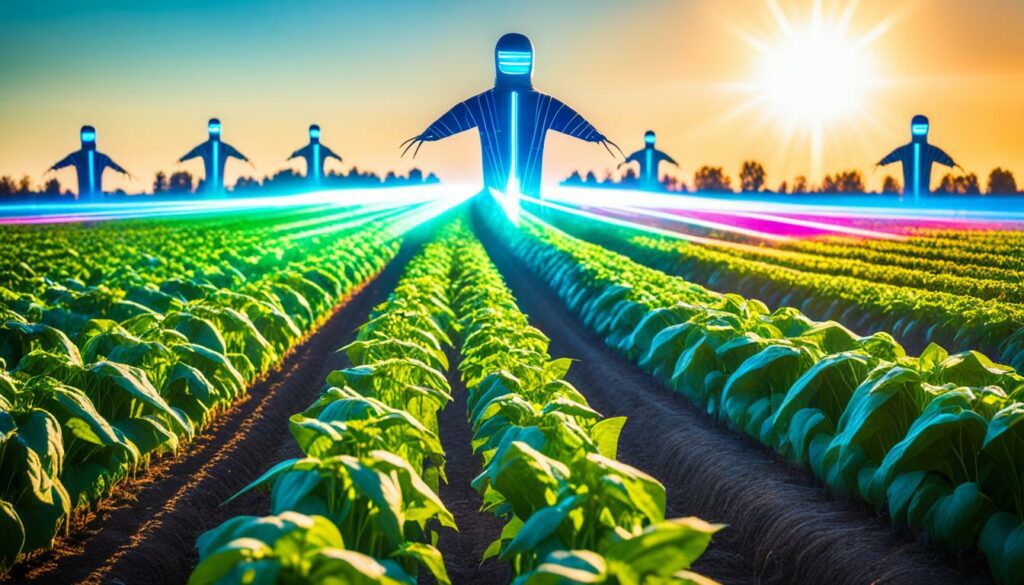
Studies show these laser scarecrows can cut crop damage by a lot within 20 metres. They work really well when sweet corn is growing. The lasers are so precise that birds don’t seem to come back once they leave. However, they don’t work well beyond 30 metres.
Farmers find this option affordable, willing to spend $300-$500 on each laser for every 1-3 weeks of bird protection. This is cheaper than using dogs or hiring people to guard the fields. One laser is usually enough to protect a whole field, as proved by tests.
There are many types of laser scarecrows, each with its own abilities and prices. For example, URI’s can protect up to nine acres for $650. Avix’s lasers, on the other hand, can cover 20-100 acres but cost $10,000. Some 50-milliwatt open-source models have been tested in New York and are planned for improvement this year.
David Brown has been a leader since 2017, introducing laser scarecrows to sustainable agriculture practices. These scarecrows are smarter and safer than the noisy ways of the past. They are part of a move towards eco-friendly farming. With everyone’s help, this new technology is showing great success in farming that helps the planet.
| Device | Coverage (Acres) | Cost (USD) |
|---|---|---|
| URI Unit | Up to 9 | $650 |
| Avix Laser | 20-100 | $10,000 |
| Open-Source 50mW | N/A (Tested on NY farms) | N/A (Available to partners) |
With the global population set to hit 9.7 billion by 2050, we need to boost agriculture productivity. Farm automation is stepping up to the challenge. By using agricultural robots and high-tech farming methods, it’s changing how we farm.
Robots are transforming farming by taking on tough jobs. They plant seeds, harvest crops, and do much more. For example, strawberry robot harvesters work as hard as 30 people, picking 25-acre fields in just three days.
This change isn’t just about doing work faster. It’s also about solving a big problem—shortages in farmworker numbers. And it’s saving farmers a lot of money by cutting labour costs, which take up over half of their spending.
Automated farming brings many advantages. It boosts how much food we can grow and uses resources smarter. This helps the planet too, by cutting down the harmful chemicals we use on crops.
Best of all, these systems save important resources like water and energy. This is a big deal because the cost of farming supplies has gone way up, between 80 to 250 percent globally.
In the US, automated spraying in big corn fields has cut down on herbicide costs a lot. This change is making a big difference for farmers. Plus, robots that put fertiliser down are saving over 93 million gallons of it a year.
With autonomous farm equipment from companies like John Deere, farming is becoming more efficient. A single farmer can now handle many machines. This is unlocking up to $1.5 billion a year in value for US corn farms.
But automation isn’t just for big farms. Even in vineyards, it’s making a big difference, boosting profit by $200 to $800 an acre. More farmers are choosing less work-intensive crops and using AI in irrigation. This switch is making life better for farmers and is better for the planet, too.
| Aspect | Traditional Farming | Automated Farming |
|---|---|---|
| Labor Cost | High (50% of total expense) | Reduced by use of robotics |
| Crop Yield | Subject to manual efficiency | Optimised via precision techniques |
| Resource Utilisation | Variable and often inefficient | Highly efficient, conserving water and energy |
| Environmental Impact | Higher due to over-application | Lower due to precise application |
Real-Time Kinematic (RTK) tech is changing how farmers work with precision. It can guide farm machines within centimetres, cutting down on soil damage and boosting eco-friendly crop care.
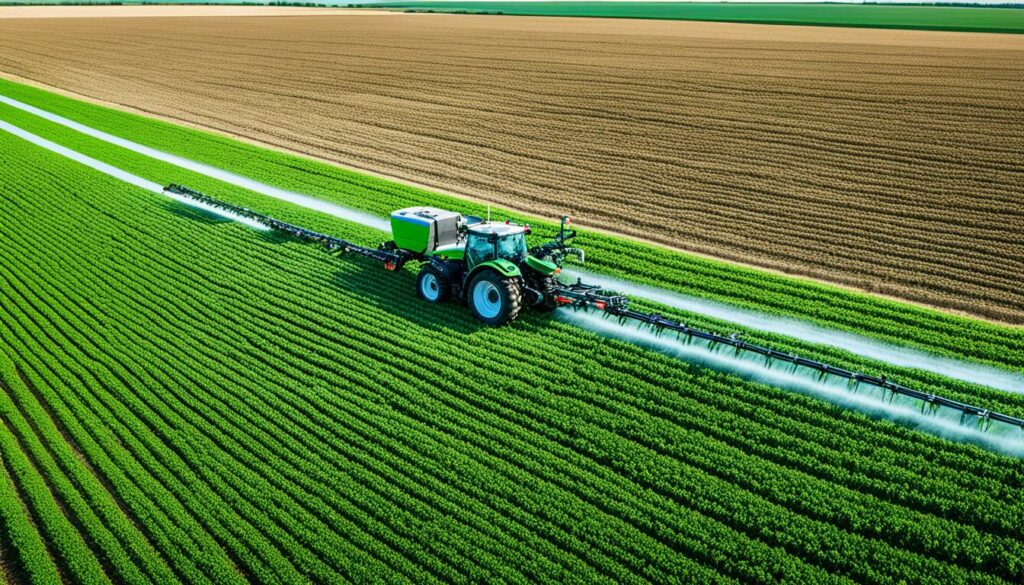
Farmers who want to use RTK need special GPS gear. A full setup is quite expensive, costing between $15,000 and $20,000 for just one part. But, they can rent this gear for about $1,500 a year. This makes high-tech farming more doable for many.
RTK networks now cover around 120 million acres of U.S. fields. Major companies like Trimble help cover 75% of that land. This shows that RTK tech is getting more popular in farming for its key role in precision farming.
By joining these networks, farmers can save quite a bit. It cuts the cost of steering systems by about 35%. For instance, Precision Ag Equipment offers a deal at about $3,500. This fee lets farmers use over 70 base stations for better farm efficiency. Plus, it offers super accurate work up to six miles away from the station.
RTK isn’t just for big farms. Smaller ones also gain from its high precision and efficiency. With the precision farming market growing fast to over $16 billion by 2028, the impact of RTK tech will keep on growing too.
Minichromosome technology is a huge step in genetic engineering in agriculture. It helps improve vital crop features without changing natural genes. This method aids in making crops that can survive droughts and resist pests, reducing the need for harmful chemicals.
The market for this technology is booming. In 2023, it’s worth USD 323.44 million. By 2029, the value is expected to jump to USD 463.30 million, growing at a rate of 6.25% each year. North America is at the forefront, investing heavily in agricultural innovation and needing higher crop yields.
Minichromosome technology is key to feeding more people and keeping our environment safe. It’s set to change how we farm sustainably, increasing what we can grow. The area benefiting most from this technology is making crops that bugs don’t like, growing the quickest.
| Year | Market Size (USD Million) | CAGR (2024-2029) | Key Market Players |
|---|---|---|---|
| 2023 | 323.44 | 6.25% | Chromatin, Inc. (Syngenta), Icon Genetics AG (Bayer AG), Evogene Ltd., Lonza Group Ltd., Precision Biosciences, Inc. |
| 2029 (Projection) | 463.30 | N/A | Chromatin, Inc. (Syngenta), Icon Genetics AG (Bayer AG), Evogene Ltd., Lonza Group Ltd., Precision Biosciences, Inc. |
The impacts of this technology reach far, affecting society and the economy. Half of the growth in businesses for the last 50 years has come from new knowledge and research. For every dollar spent on this research, ten dollars is gained in economic growth. The success of the Human Genome Project shows how large the benefits can be.
Looking ahead, including minichromosome technology in farming is crucial. It allows us to use genetic engineering for eco-friendly food solutions. This helps us meet the food needs of our growing population, moving us towards a greener and more enduring agricultural sector.
Farm management software is changing how we do farm work. It uses SaaS in agriculture to make farming more efficient. It does this by pulling in real-time data. This helps farmers make smart choices that improve their farms.
This software has over 40 quick and easy farm reports. These reports give farmers fast insights. It also helps manage all kinds of livestock, from cattle to pigs to poultry. For organic farms, it supports making reports easy. Best of all, you can update farm records from any device.
FarmERP is top software used by farms in over 25 countries since 2001. It’s great for selling farm products online. And you don’t need much training to start using it, which is a big plus. FarmERP is also a part of important agriculture programs, promoting a more complete and diverse way of farming.
This software improves how farms run by handling planning and estimates. It spots trends and fixes issues fast. Because of this, farms become more productive and green. FarmERP is big – it looks after 600K acres and helps everyone from small fruit farms to large organic ones. Its main aim is to help farming be sustainable and safe for food.
Water management technology is key in making agriculture more sustainable. It improves irrigation efficiency and helps save natural resources. With a big part of the world’s water going to farming, efficient water use is crucial.
Drip irrigation stands out for its water-saving approach. It steers clear of water loss through evaporation and runoff. This method not only saves water but also boosts plant growth. It’s also vital to save and store water, get the timing of irrigation right, and keep our soil healthy to preserve water.
The world’s food production needs to rise by about 70% by 2050. This highlights the need for advanced water management.
Methods like dry farming and crop rotation help use less water. They also make the soil healthier, leading to better crops. With such practices, farming can meet the demands of a growing world while protecting water.
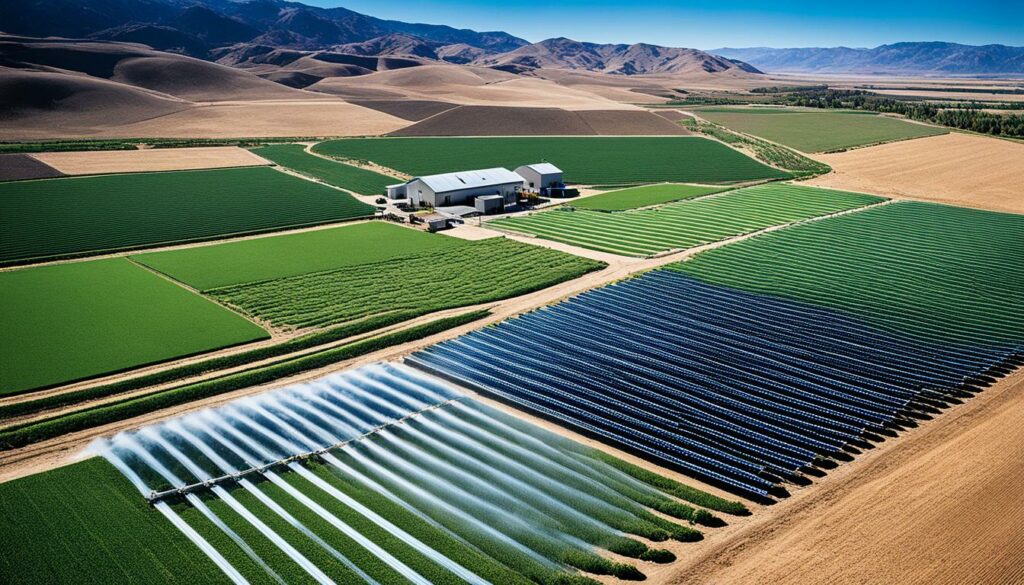
Farming uses a lot of water, which is why we need creative solutions. For example, efforts to recycle water can save large amounts during growing seasons. Using treated wastewater for plants also lessens the need for fresh water, showing how essential water tech is in farming’s future.
Digital farming, with things like remote sensing and data analysis, makes water use smarter. This includes tracking weather to know when to water crops best. Such tools and methods make farming more sustainable long term.
| Water Conservation Technique | Benefits |
|---|---|
| Drip Irrigation | Reduces water loss through evaporation and runoff, promotes plant health |
| Rainwater Harvesting | Provides an alternative water source, reduces dependence on groundwater |
| Precision Agriculture | Optimises water use, enhances sustainable practices through remote sensing and data analytics |
| Conservation Tillage | Improves soil health, retains moisture |
| Water Recycling | Saves millions of gallons, reduces runoff impact on ecosystems |
Through the use and improvement of these water management technologies, we aim for better, smarter farming. Our goal is to boost farm output sustainably. Together, we can make a big impact by saving water and other resources.
The world of organic farming is changing fast. New organic farming companies are using high-tech solutions to tackle farming problems. After looking at 208 firms, we selected 5 that are true leaders in sustainable agriculture innovations. These companies are focused on making farms more productive and eco-friendly with their unique methods and tools.
Green BTS shines by creating organic pesticides. Their product, G-BIO, is both a biofungicide and a biofertiliser. It fights off more than 40 pests and diseases. This shows their dedication to greener farming practices.
Agripolis is a French business leading in urban farming. They use rooftops and city spaces for growing organic food. This cuts down on how far food has to travel, supporting local farming in big cities, a standout effort by city-centric organic farming companies.
OrganicNet from Serbia is all about connecting people to organic food. They run an online market that links buyers directly with organic farmers. This helps make food buying and selling clear and open, marking them as innovative in the industry.
In Singapore, Protenga is using insects to turn organic waste into protein. Their Smart Insect Farms are at the forefront of sustainable farming, making both environmental and economical sense. This approach reduces waste and creates a valuable food resource.
Finally, Australia’s SOSBio is making waves with CropUp, an organic fertiliser. It boosts plant health and growth naturally. This shows the key place of modern farming methods in creating better, nutrient-rich soil for plant growth.
Modern technology has deeply changed organic farming. It has brought about big environmental and social benefits in agriculture. These changes are helping to keep our planet in balance for the long run.
New farming tech is a big plus for the environment. Organic methods like green manure and compost help stop soil erosion and save water. They also cut down on pollution. Machines and new inventions in farming make these green ways work even better, saving more resources.
This new tech also helps fix the problems from old farming styles. That means less use of bad chemicals, which are expensive and hurt our earth. Machines now do more work, making farms produce more, cost less, and do it all cleaner.
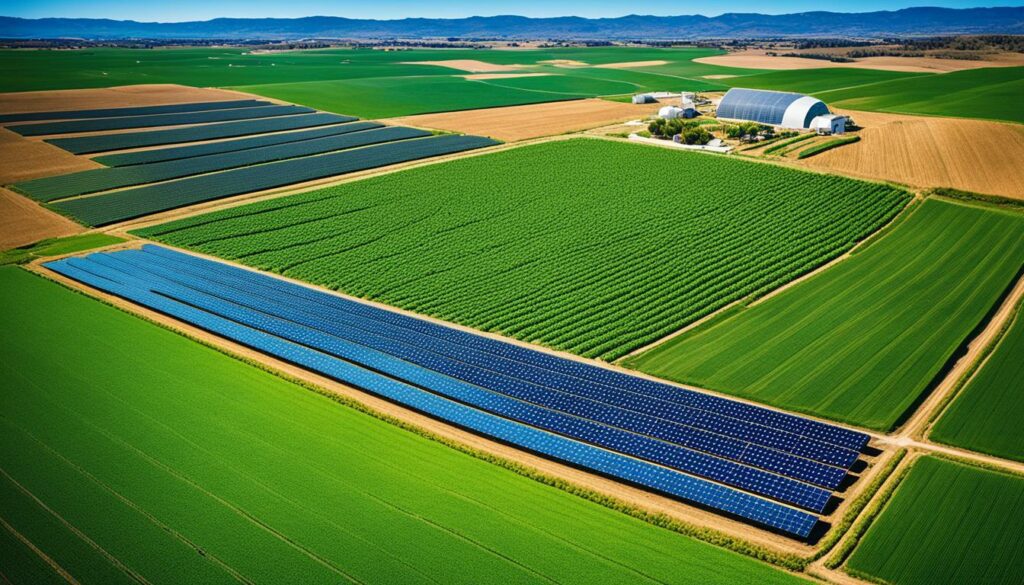
Things like drones and big data make it easier to use resources wisely. This helps farms cut waste and support the earth at the same time. These smart tools lead to farming that’s better for our planet.
The effects on societies and economies are just as big. Smart tech gives farmers better data and advice, making farms more successful. This boosts profits and makes farms stand strong against tough times.
Farmers also get more say in what they grow and how. This makes food more secure and keeps communities stable. New technology helps make sure food is safe, prevents crop losses, and keeps prices fair.
The tech market for green solutions is growing fast. This means more smart tools for farming, like drones, will be key in the future. They are set to make sure farming is smart and does well for our planet and communities.
“Sustainable agriculture is more than just farming without chemicals; it’s about leveraging modern technologies to create a balanced and resilient ecosystem.”
Small-scale farmers are vital in the world of organic farming. They work on farms below 100 acres. The right technology is essential for their success.
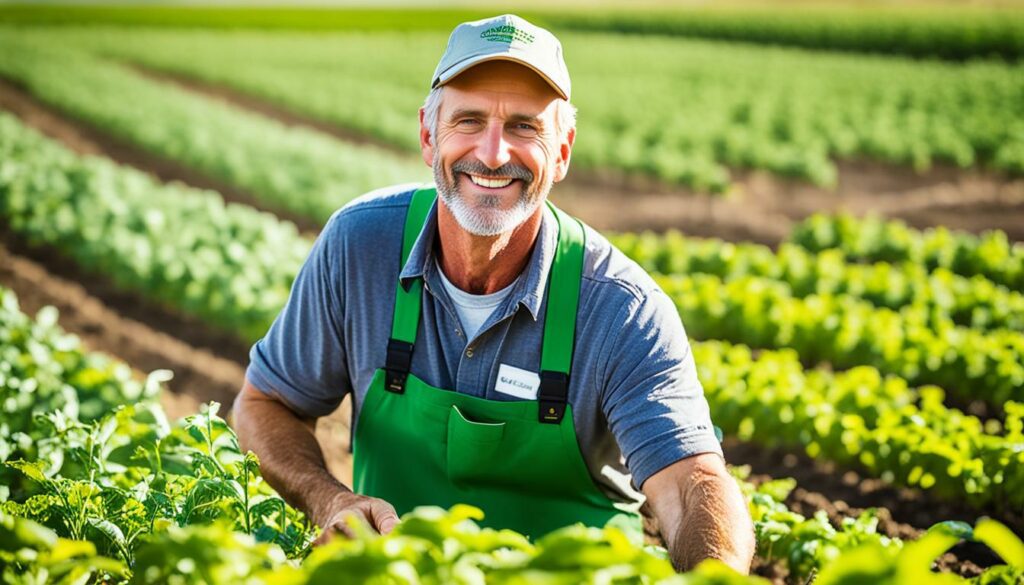
By using community-based farming solutions and accessible agriculture technology, these farmers can boost their yields. At the same time, they keep their farming ways eco-friendly. Techniques like electric fencing and drip irrigation have helped a lot. Today, 90% of these farmers use such modern methods.
Organic farming is kind to the planet. It needs less energy than usual farming. And it cuts down on harmful gases, helping fight climate change. Organic farms can even store a lot of carbon, making a big impact.
Technology is changing how small farms operate in big ways. It helps them in:
The right tech and approaches are key. They make small-scale farming stronger. This helps with making plenty of good, healthy food for everyone. Farmers are able to work in a more eco-friendly way.
| Advantage | Organic Farming | Conventional Farming |
|---|---|---|
| Energy Requirement | 28-32% less | Higher |
| GHG Emissions Reduction | Approx. 20% | Lower |
| CO2 Sequestration Potential | 2.4-4Gt CO2e yr-1 (up to 11.7Gt with new technologies) | Lower |
| Fossil Fuel Usage | Minimal | High |
We must support the use of tech in organic farming for small farms. It’s the way to a sustainable future. This approach benefits not just the farms but also our planet and its people.
Organic farming is moving forward with new technology. These innovations are the key to a farming revolution. They help farmers grow better crops that are healthier for us and the planet.
New tools like precision agriculture, vertical farming indoors, and water-saving methods show technology’s big impact. Features like bee vectoring and smart farm software are great for both the environment and the pocket. Studies show organic farming can reduce a lot of CO2, making it good for the Earth.
Not using strong chemicals helps protect wildlife and plants. It makes the soil and nature stronger. It also means our food is safer. There’s a growing interest in organic food due to its health and environment benefits.
The advancements we’ve seen paint a bright future for organic farming. We all have a part to play in making the Earth healthier. The growth of farming tech shows this dedication, pushing organic farming worldwide.
Bee Vectoring Technology (BVT) uses bees to carry pest control to crops. It’s a natural way to protect plants and make farming better.
BVT boost crop growth, improves soil, and keeps pests away safely. By using bees, it makes farming greener and more focused.
BVT cuts down on chemical pesticides. This helps the environment by reducing pollution and encouraging eco-friendly farm methods.
Precision agriculture uses advanced tech for farming. It includes things like drones, sensors, and machines that work on their own.
GPS, moisture sensors, and smart machinery are key in precision farming. They make farming more efficient and Earth-friendly.
The future looks bright for precise farming. It’s valued at .35 billion by 2028, showing it’s changing farming for the better.
Hydroponics and aeroponics grow plants without soil. They use water with nutrients or a fine mist. This way, they save resources and grow more in a controlled space.
Indoor farms save water and energy. They cut down on work because machines do a lot. Also, they make sure plants grow just right, resulting in healthy and big harvests.
Studies show that these farms can grow more food, such as rice. They also follow the eco-friendly rules of farming.
New tech in livestock farming includes robotic milking and systems that help sick cows. There are also smart feeding systems to care for animals better.
Laser scarecrows use light and motion to scare birds away. They’re a safe and green way to protect crops.
Farm robots and smart machines make farming better. They cut mistakes, boost harvests, and save resources, making farms more productive.
RTK gives very accurate maps and guides for farming machines. This helps farms avoid damage to soil and work better.
Minichromosome tech makes crops better without changing their base genes. It helps crops resist water shortage and pests, which means fewer harmful chemicals.
Farm software gathers real-time data and helps plan. It makes farms run smarter, using resources better.
This software makes farming operations more effective. It improves buying, handling, money, and daily tasks, leading to better farms.
Water tech makes watering crops efficient. It saves water, making sure plants have enough, even in dry places.
New firms that use robots, AI, and indoor farming are the ones to look out for. They offer new ways to keep soil healthy and grow food without pests.
Tech helps save the Earth by using fewer chemicals, keeping more plant and animal types, and making food safely and at good prices.
Small farmers are vital for healthy farming. They can use easy, scalable tech to grow and protect crops in a green way.